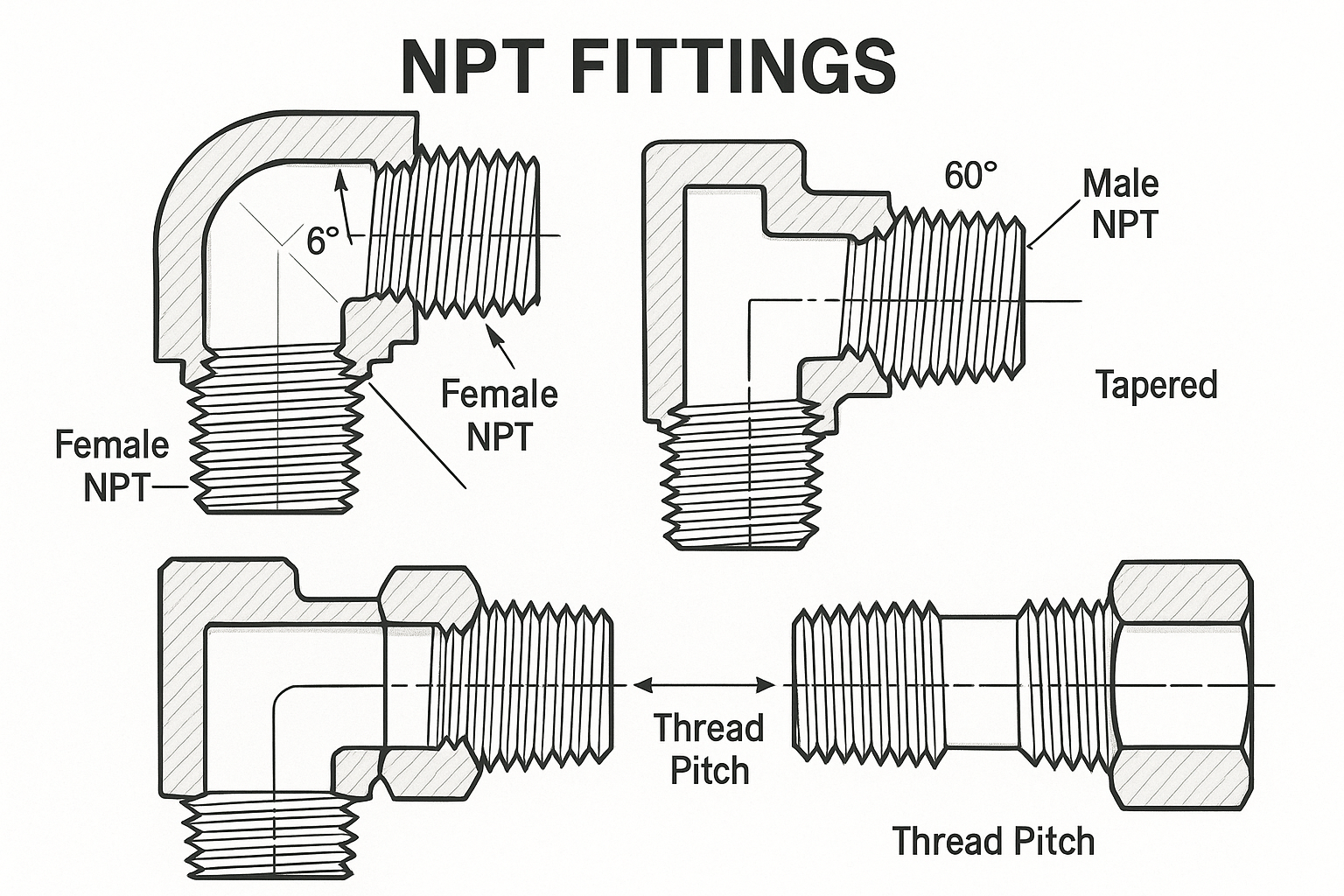If you’ve worked with plumbing, industrial piping, or hydraulic systems, you’ve likely encountered NPT fittings—one of the most widely used pipe connection standards in North America. Short for National Pipe Tapered, NPT fittings are threaded components designed to create leak-tight seals in low-to-high pressure systems. Unlike straight-threaded fittings, their tapered design ensures a secure, self-sealing connection—making them indispensable in plumbing, oil and gas, manufacturing, and construction.
What is an NPT Fitting Used For?
At its core, an NPT fitting joins two sections of pipe or connects pipes to valves, pumps, or fixtures. Its primary role is to:
- Prevent Leaks: The tapered threads compress against each other, creating a mechanical seal that blocks fluid or gas from escaping.
- Withstand Pressure: Suitable for systems handling water, air, oil, natural gas, or chemicals (up to 10,000+ PSI, depending on material and size).
- Simplify Installation: No need for gaskets (though sealant/tape is often used); the threads themselves form the seal.
Common examples: A ½-inch NPT elbow fitting in a home’s water line, or a 2-inch NPT coupling connecting sections of a factory’s hydraulic system.

How Do NPT Fittings Work?
The secret lies in their tapered threads:
- Thread Design: NPT threads slope at a 1° 47′ (1.78°) angle, with a “taper rate” of ⅛ inch per inch of thread length. As the fitting is tightened, the male (external) and female (internal) threads wedge together, deforming slightly to seal gaps.
- Sealing Method: While the taper provides a basic seal, most installations use thread sealant (paste or tape) to fill micro-gaps and prevent leaks—especially for gases or high-pressure liquids.
- Hand-Tight + Wrench Turns: NPT fittings are tightened by hand until snug, then turned 1–3 more wrench turns to achieve proper compression (over-tightening can crack the fitting).
Types of NPT Fittings: Shapes & Applications
NPT fittings come in dozens of configurations to suit different piping needs. Here are the most common types:
| Fitting Type | Shape/Function | Typical Use Case |
|---|---|---|
| Coupling | Straight, connects two equal-diameter pipes | Extending a water line in a basement. |
| Elbow | 90° or 45° bend, changes pipe direction | Navigating around walls in plumbing. |
| Tee | T-shaped, splits flow into two branches | Distributing water from a main line to two fixtures. |
| Reducer | Connects large and small diameter pipes | Adapting a 1-inch main line to a ½-inch fixture. |
| Plug/Cap | Seals the end of a pipe | Closing off unused ports on a valve manifold. |
NPT vs. Other Thread Standards: What’s the Difference?
Confused about NPT vs. BSP, NPTF, or G-threads? Here’s a quick breakdown:
NPT vs. BSP (British Standard Pipe)
- NPT: Tapered threads, used primarily in North America. Seal via thread compression + sealant.
- BSP: Can be tapered (BSPT) or straight (BSPP). BSPT is similar to NPT but has a different thread angle (55° vs. NPT’s 60°), so they’re not interchangeable.
NPT vs. NPTF (Dry-Seal NPT)
- NPT: Requires sealant/tape to prevent leaks.
- NPTF: “Dry-seal” design with modified thread roots and crests that form a metal-to-metal seal without sealant—ideal for high-vibration applications (e.g., heavy machinery).
Materials: Choosing the Right NPT Fitting
NPT fittings are made from materials tailored to their environment:
- Brass: Affordable, corrosion-resistant, and easy to machine—common in residential plumbing (e.g., faucet connections).
- Stainless Steel (304/316): Withstands harsh chemicals, saltwater, and high temperatures—used in food processing, marine systems, or chemical plants.
- Carbon Steel: Strong and durable for high-pressure industrial systems (e.g., oil pipelines, hydraulic equipment).
- PVC/CPVC: Lightweight and chemical-resistant, used in low-pressure water or drainage systems (not for hot liquids).
Key Tips for Installing NPT Fittings
- Clean Threads: Remove dirt, rust, or debris before installation to avoid cross-threading.
- Use Sealant Sparingly: Apply Teflon tape (clockwise direction) or pipe dope to male threads only—too much can clog valves or contaminate fluids.
- Avoid Over-Tightening: Brass fittings crack easily; stop when resistance increases significantly.
- Check Compatibility: Never mix NPT with BSP or other thread types—mismatched threads will leak or seize.
Final Thoughts
NPT fittings are the backbone of reliable pipe connections in countless industries, thanks to their simple design, leak resistance, and versatility. Whether you’re fixing a kitchen sink or assembling an industrial hydraulic system, understanding NPT basics—from tapered threads to material choices—will ensure a safe, long-lasting seal. For most projects, brass or stainless steel NPT fittings (paired with quality sealant) strike the perfect balance of performance and affordability.

